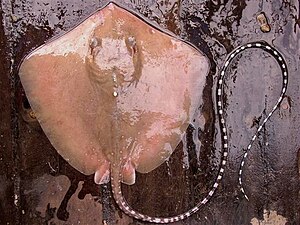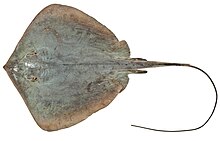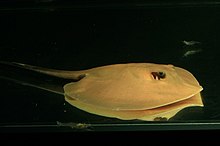Hemitrygon
| Hemitrygon | ||||||||||||
|---|---|---|---|---|---|---|---|---|---|---|---|---|

Hemitrygon bennettii , the type species |
||||||||||||
| Systematics | ||||||||||||
|
||||||||||||
| Scientific name | ||||||||||||
| Hemitrygon | ||||||||||||
| Müller & Henle , 1838 |
Hemitrygon is a genus from the family of stingrays (Dasyatidae), which occurs on the coast of the Indo-Pacific between India and Indonesia and north to the coast of Korea and the Japanese main island of Honshū . One species, Hemitrygon fluviorum , lives on the north and east coast of Australia, as well as on the south coast of New Guinea , while another, the Laos stingray ( Hemitrygon laosensis ), lives in thefresh water of the Mae Nam Chao Phraya and Mekong riversin Thailand and Laos in front.
features
Hemitrygon species are small to medium-sized rays that reach a body disc width of 34 to 93 cm. The body disc is more or less rhombic, the outer ends of the pectoral fins broad or short rounded. The pelvic fins are medium to large in size and protrude slightly over the body disc. The snout is pointed at wide angles or moderately long. The slightly protruding eyes are small to very small. The mouth is narrow to medium-sized and surrounded by one to seven oral papillae, three of which are usually positioned in the middle. The tail is short or whip-like and long. Its length can reach 0.8 to 2.9 times the diameter of the body disk. The tail base is oval in cross section and not particularly wide. The tail has a low dorsal skin fold, which is usually reduced to a ridge, and a ventral skin fold, which can be short or long. The sting sits far in front on the tail, further tail spines may be present or absent. There is a central row of thorns on the body disc, but it can also be missing. The skin of the back is smooth or covered with spotty denticles. Shoulder denticles may be present or absent. On the back, the Hemitrygon species are monochrome, the belly is white. The edges of the body disc can be yellowish or orange. The tail is usually blackish behind.
species
Currently (July 2020) eleven species are included in the genus Hemitrygon :
- Hemitrygon akajei (Müller & Henle, 1841),
- Hemitrygon bennettii (Müller & Henle, 1841),
- Hemitrygon fluviorum (Ogilby, 1908),
- Hemitrygon izuensis (Nishida & Nakaya, 1988),
- Hemitrygon laevigata (Chu, 1960),
- Laos stingray ( Hemitrygon laosensis (Roberts & Karnasuta, 1987)),
- Hemitrygon longicauda (Last & White, 2013),
- Hemitrygon navarrae (Steindachner, 1892),
- Hemitrygon parvonigra (Last & White, 2008),
- Hemitrygon sinensis (Steindachner, 1892).
- Hemitrygon yemenensis Moore et al., 2020
The genus needs a revision , some of the species currently considered valid are possibly synonym descriptions , while others have not yet been described.
Systematics
The genus Hemitrygon was introduced in mid-1838 by Johannes Müller and Jakob Henle as a sub-genus of Trygon , but later synonymous with Trygon with Dasyatis . In mid-2016, the genus was reintroduced for ten Indo-Pacific stingray species by the Australian marine biologist Peter R. Last, the US ichthyologist Gavin JP Naylor and another colleague. The type species of the genus is Hemitrygon bennettii (Müller & Henle, 1841).
Individual evidence
- ↑ a b Hemitrygon fluviorum on Fishbase.org (English)
- ↑ Hemitrygon laosensis on Fishbase.org (English)
- ↑ Hemitrygon parvonigra on Fishbase.org (English)
- ↑ a b c d Last, PR, Naylor, GJP & Manjaji-Matsumoto, BM (2016): A revised classification of the family Dasyatidae (Chondrichthyes: Myliobatiformes) based on new morphological and molecular insights. Zootaxa , 4139 (3): 345-368. doi: 10.11646 / zootaxa.4139.3.2 , page 355.
- ↑ Moore, ABM, Last, PR & Naylor, GJP (2020): Hemitrygon yemenensis sp. nov., a new species of stingray (Myliobatoidea: Dasyatidae) from the northwestern Indian Ocean. Zootaxa, 4819 (2): 364-374.

